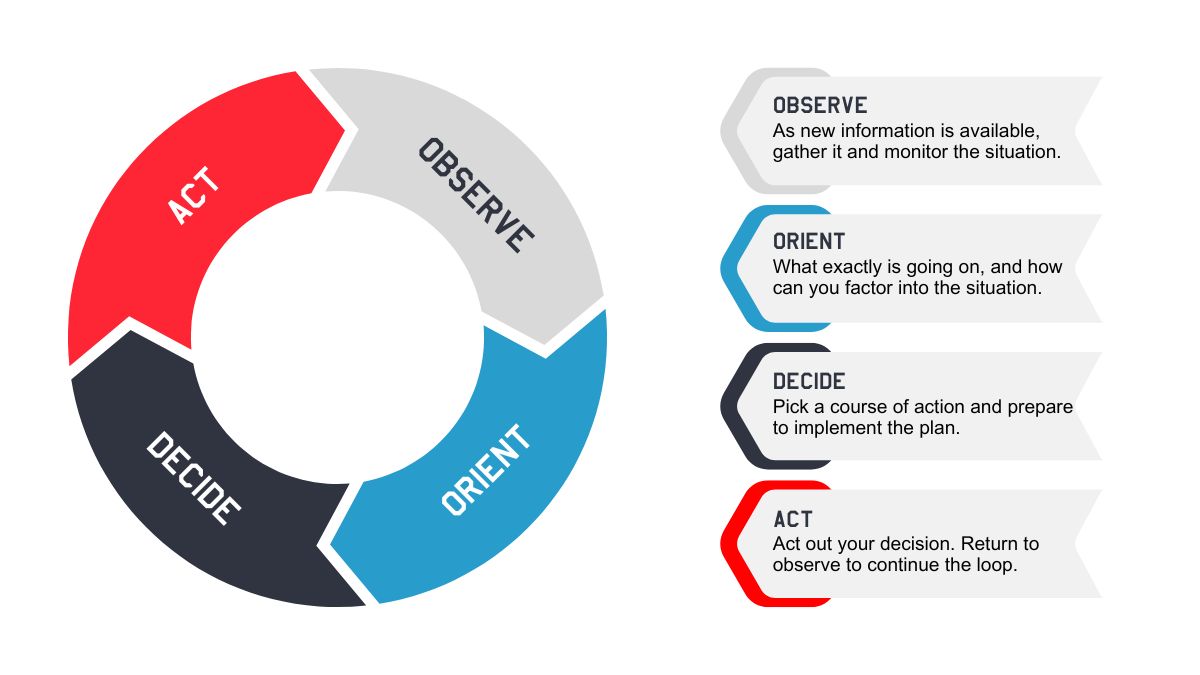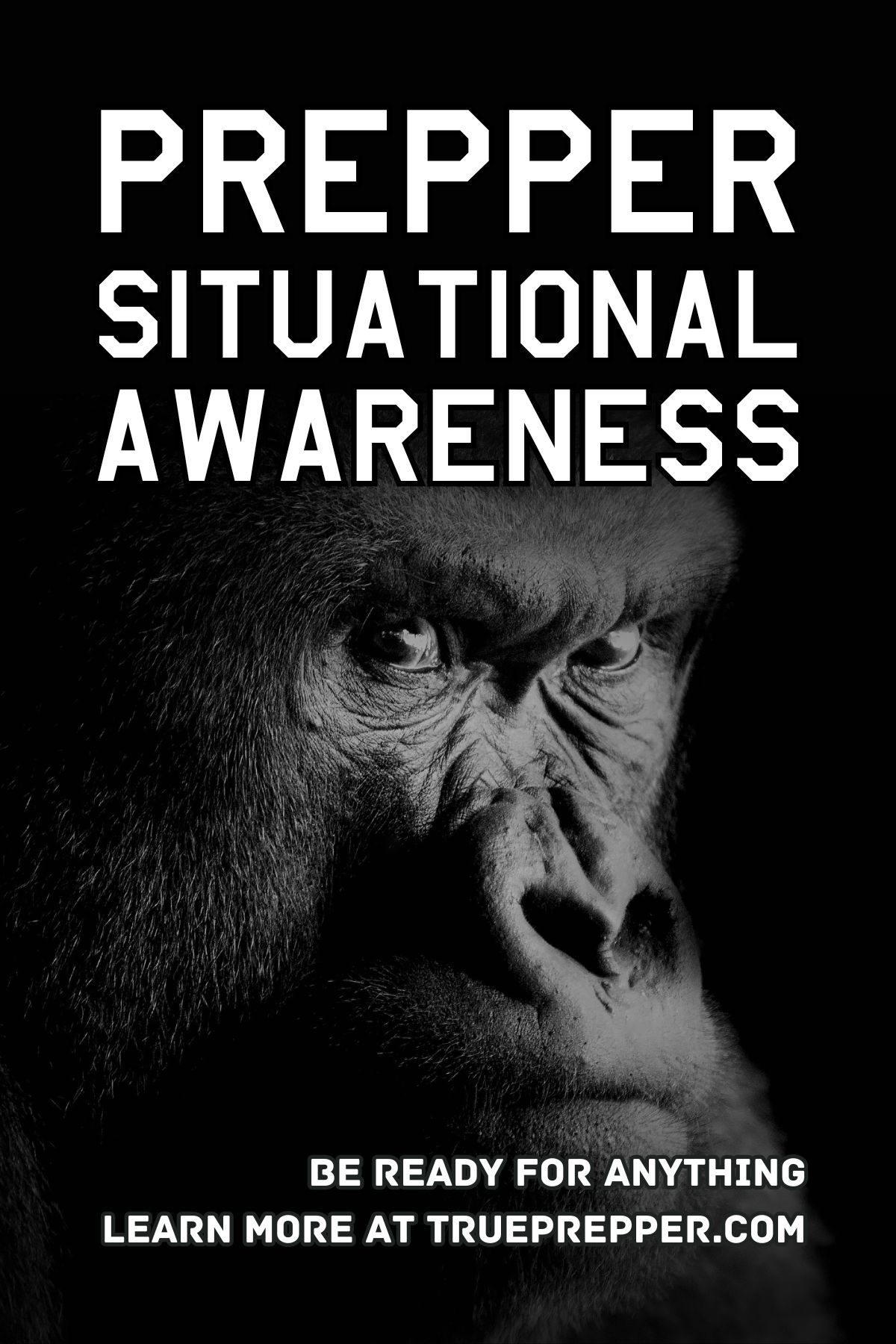Situational awareness is just understanding what is going on around you. Prepper situational awareness involves understanding potential threats, how you are positioned against them, and how to avoid or mitigate them.
Situational awareness (sometimes abbreviated SA) is earned with practice and wisdom, yet it can still be taught. When you find yourself complacent, you slowly lose it. If you follow the basics, you slowly improve it. If you focus on situational awareness too much, you can even be counterproductive.
Contents (Jump to a Section)
Levels of Situational Awareness
Typically, situational awareness is described in five color levels called Cooper’s Color Code (after the Marine that coined it):
- White (Tuned Out) – off guard and unaware of surroundings.
- Yellow (Alert) – aware of surroundings and periodically scanning for threat changes.
- Orange (Focused) – attentive and monitoring a specific threat with high alertness.
- Red (Active) – responding, engaging, or retreating from a threat.
- Black (Panic) – physical and mental breakdown.
Having the mindfulness to understand which level you’re in and what the situation requires takes time and practice.
The main goal for prepper situational awareness is to have the understanding, tools, and skillset to move between these levels seamlessly as you need, while hopefully avoiding the black level.
OODA Loop
Observe, Orient, Decide, and Act is a decision-making tool that is often used for situational awareness. Developed by military strategists, with a little bit of practice it becomes a smooth loop rather than a lock-step procedure.

Using the OODA loop as a tool can help preppers filter, understand, and focus on relevant information. It also can help you avoid decision paralysis or focus lock.
Observe
Gathering information is the first part of the loop. Stay aware of your surroundings and hazards in the area. Vigilance is key to success, noticing out-of-the-ordinary events with all your senses, including odd smells and sounds.
Orient
If you notice anything out of the ordinary during the observation step, you move to the orientation step. This is where you take a moment to figure out what exactly is going on, and the potential hazards that might be at play. Pattern detection and predicting outcomes come into play here but you usually have to be quick about it.
Decide
Once you have stock of the situation you’ll need to choose what you do. That could be fight or flight- up to you.
Some people hesitate here in indecision feeling like they may not have enough information. Perfect information is impossible, so you’ll need to trust your gut, what you’ve observed, and what you expect.
Act
Finish out the loop by acting out your decision. If your actions don’t have the results you expect, start the loop over. Trying something different should be expected, as most challenges in life are rarely solved with one set of decisions and one action.
Prediction
Being able to predict what happens comes down to knowledge and experience. Knowledge can be learned whereas experience cannot without drills, exercises, or active involvement.
History can inform what is likely at certain places and who will be involved. For example, banks typically have happy customers, disgruntled customers, or very rarely: bank robbers.
Jumping to conclusions can be counter-productive too, because there are always outliers. Children and senior citizens are not typically violent crime perpetrators, but an 11-year-old and an 88-year-old have both been active shooters in the United States already.
Seeing these outliers is easier using pattern detection.
Pattern Detection
Studying people as they move around you is a skill and a habit that can protect you well. If you were in the military, you may be familiar with the zone-scanning type of procedure.
It can be adapted to however you like, but here is a common use of pattern detection:
When someone is within 20 feet of you, observe their appearance. This information can feed into the Observe part of your OODA loop and predictive skills. If they are wearing all black, have their hands in their pockets, are moving quickly, or have their face covered- it could be out of place depending on where you are and what you are doing yourself.
When someone is within 10 feet look at their facial features and try to discern their emotions. To aid in this, making eye contact and extending a smile is often suggested- but that can depend on your own situation. Our gray man concept would discourage that if you want to go unnoticed yourself.
Your target’s response or lack of response to a friendly gesture can give you even more information about their intentions and move your OODA loop quickly into a decision and action. Besides identifying individuals that could disrupt the environment, you use pattern detection to prevent would-be attackers from getting close.
Next, we’ll go over a few barriers to situational awareness that you should be aware of.
Fallible Intuition
Consider this question as quickly as possible:
A baseball bat and ball cost $1.10. If the bat costs $1 more than the ball, how much is the ball?
Intuition quickly comes up with $0.10 for the answer but intuition is wrong here. And it’s not because we’re dumb- our brain processes information quickly and with less accuracy when it needs to go fast.
You may have had a nagging feeling the answer wasn’t $1, but that $1 answer just feels easier.
Inattentional Blindness
Let’s take the situational awareness basketball test if you haven’t seen this. It is a short video that tests your awareness and attention to detail.
Follow the instructions in the video below to test your attention to detail. It will ask you to count the number of passes by one of the teams and they pass the ball relatively quickly. It is slightly over a minute long:
Did you get the number of passes correct?
If you found the results interesting, share the video (or this whole post) with a few friends to see if they get the same answer.
How Does This Apply to Preppers?
At this point, we’re far down enough to talk about the gorilla without spoiling anything.
Half of the people who watch this video and follow the instructions to count the passes miss the gorilla entirely.
According to Cooper’s Colors, if you missed the gorilla in the video you were in the Orange “Focus” zone and just experienced a focus lock. This can cause you to miss some things, but sometimes it’s beneficial to focus at a higher level on a single thing. It is more a phenomenon you need to be aware of rather than avoid completely.
A study conducted by Harvard noted this intentional blindness phenomenon and stressed how there is so much in life that we miss. We are bombarded by information and stimuli from our senses as our brain attempts to sort out what is important and what isn’t- sometimes ineffectively.
There is no good method for noticing every possible thing. We biologically can’t. It’s science.
What we can do, though, is improve our situational awareness by telling our brains what to prioritize. Next time you see this video, you’ll know what to expect.
The Final Word
Complacency creeps in for even the most vigilant. If you are not focused on continuously improving your skills, they are eroding.
The saying goes “Practice makes perfect”… but it doesn’t. There is no ‘perfect.’ All practice does is give you experience that you can lean on when you actually need to apply your learned wisdom. There is no substitute for living through the real thing, but practice sure does come close.
If you are routinely prepared for typical problems, you will more easily notice strange things around you. Suspicious people and events will stand out much more clearly in situations that you are comfortable in.
Here are some other guides our subscribers have found helpful:
Keep exploring, stay prepared, and be safe.
You’ve Been Missing Out
Join the 2+ million preppers that rely on our prepping advice by subscribing to TruePrepper.
- Practical guides and tips
- Useful survival giveaways
- Free, forever
- < 0.4% of people unsubscribe
Thanks for subscribing, reading, and welcome to the club.

The post Prepper Situational Awareness appeared first on TruePrepper.
https://trueprepper.com/situational-awareness/
 CampingSurvivalistHuntingFishingExploringHikingPrivacy PolicyTerms And Conditions
CampingSurvivalistHuntingFishingExploringHikingPrivacy PolicyTerms And Conditions
